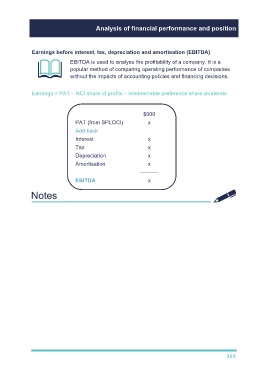Page 363 - Microsoft Word - 00 CIMA F1 Prelims STUDENT 2018.docx
P. 363
Analysis of financial performance and position
Earnings before interest, tax, depreciation and amortisation (EBITDA)
EBITDA is used to analyse the profitability of a company. It is a
popular method of comparing operating performance of companies
without the impacts of accounting policies and financing decisions.
Earnings = PAT – NCI share of profits – irredeemable preference share dividends
$000
PAT (from SPLOCI) x
Add back
Interest x
Tax x
Depreciation x
Amortisation x
––––––
EBITDA x
TUTOR GUIDANCE
EBITDA is commonly quoted by large companies who have significant depreciation
and amortisation charges as a basis for assessing their operating performance. It
can be used as a gimmick to improve the perception of a company’s performance.
It is commonly but inaccurately used as a measurement of cash flows. EBITDA can
be used to measure profitability but is only an approximation of operating
cashflows. This is because no impacts of accruals or working capital movements
have been considered when determining EBITDA.
355

